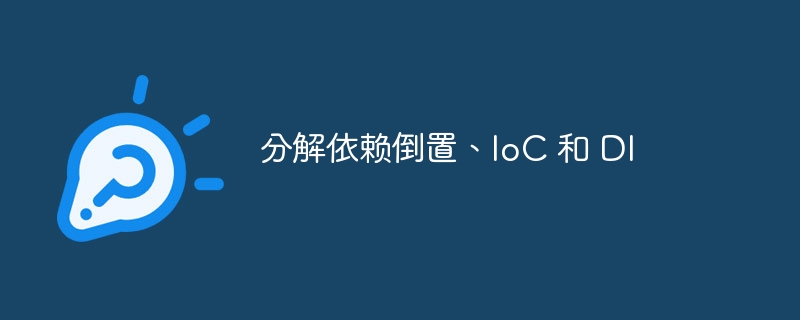分解依赖倒置、IoC 和 DI
时间:2025-01-20 16:51:43 122浏览 收藏
你在学习文章相关的知识吗?本文《分解依赖倒置、IoC 和 DI》,主要介绍的内容就涉及到,如果你想提升自己的开发能力,就不要错过这篇文章,大家要知道编程理论基础和实战操作都是不可或缺的哦!

本文深入探讨 NestJS 依赖注入系统,并阐明依赖倒置原则 (DIP)、控制反转 (IoC) 和依赖注入 (DI) 的概念及其关联。这三个概念看似相似,实则各有侧重,相互关联却又解决不同的问题。本文旨在帮助读者理清这些概念,并理解它们如何协同工作。
-
依赖倒置原则 (DIP)
定义:
高层模块不应该依赖于低层模块;两者都应该依赖于抽象。抽象不应该依赖于细节;细节应该依赖于抽象。
含义解读
在软件开发中,高层模块负责核心业务逻辑,而低层模块处理具体的实现细节(例如文件系统、数据库或 API)。若无 DIP,高层模块直接依赖于低层模块,导致紧密耦合,从而:
- 降低灵活性。
- 复杂化测试和维护。
- 难以替换或扩展低层细节。
DIP 颠覆了这种依赖关系。高层和低层模块都依赖于共享的抽象(接口或抽象类),而不是高层模块直接控制低层实现。
无 DIP 示例
Python 示例
import "reflect-metadata";
import { injectable, inject, container } from "tsyringe";
@injectable()
class EmailService {
sendMessage(message: string): void {
console.log(`Email sent: ${message}`);
}
}
@injectable()
class Notification {
constructor(@inject(EmailService) private emailService: EmailService) {}
notify(message: string): void {
this.emailService.sendMessage(message);
}
}
// DI 容器
const notification = container.resolve(Notification);
notification.notify("This is Dependency Injection in TypeScript!");
DI 的优势:
- 简化测试:轻松使用模拟对象替换依赖项。
- 提高可扩展性:添加新的实现而无需修改现有代码。
- 增强可维护性:减少系统某一部分变更的影响。
今天关于《分解依赖倒置、IoC 和 DI》的内容介绍就到此结束,如果有什么疑问或者建议,可以在golang学习网公众号下多多回复交流;文中若有不正之处,也希望回复留言以告知!
相关阅读
更多>
-
501 收藏
-
501 收藏
-
501 收藏
-
501 收藏
-
501 收藏
最新阅读
更多>
-
341 收藏
-
423 收藏
-
295 收藏
-
154 收藏
-
294 收藏
-
479 收藏
-
221 收藏
-
264 收藏
-
363 收藏
-
171 收藏
-
216 收藏
-
160 收藏
课程推荐
更多>
-

- 前端进阶之JavaScript设计模式
- 设计模式是开发人员在软件开发过程中面临一般问题时的解决方案,代表了最佳的实践。本课程的主打内容包括JS常见设计模式以及具体应用场景,打造一站式知识长龙服务,适合有JS基础的同学学习。
- 立即学习 543次学习
-

- GO语言核心编程课程
- 本课程采用真实案例,全面具体可落地,从理论到实践,一步一步将GO核心编程技术、编程思想、底层实现融会贯通,使学习者贴近时代脉搏,做IT互联网时代的弄潮儿。
- 立即学习 516次学习
-

- 简单聊聊mysql8与网络通信
- 如有问题加微信:Le-studyg;在课程中,我们将首先介绍MySQL8的新特性,包括性能优化、安全增强、新数据类型等,帮助学生快速熟悉MySQL8的最新功能。接着,我们将深入解析MySQL的网络通信机制,包括协议、连接管理、数据传输等,让
- 立即学习 500次学习
-

- JavaScript正则表达式基础与实战
- 在任何一门编程语言中,正则表达式,都是一项重要的知识,它提供了高效的字符串匹配与捕获机制,可以极大的简化程序设计。
- 立即学习 487次学习
-

- 从零制作响应式网站—Grid布局
- 本系列教程将展示从零制作一个假想的网络科技公司官网,分为导航,轮播,关于我们,成功案例,服务流程,团队介绍,数据部分,公司动态,底部信息等内容区块。网站整体采用CSSGrid布局,支持响应式,有流畅过渡和展现动画。
- 立即学习 485次学习
